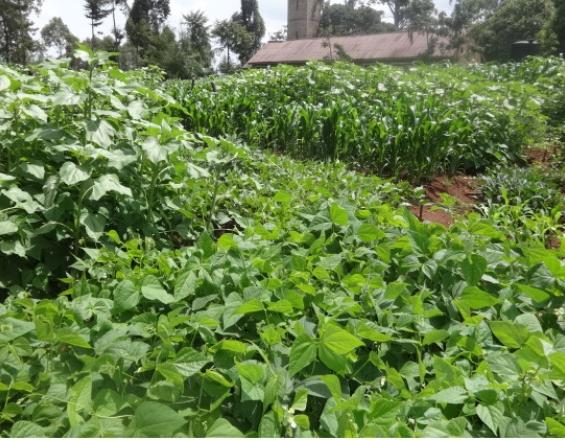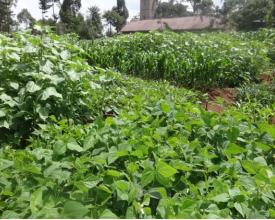
Agricultura biointensiva para mejorar la nutrición, la renta y la seguridad alimentaria

Más del 70% de los agricultores de Kenia son pequeños agricultores que practican la agricultura convencional y utilizan fertilizantes. Esto es insostenible y produce la mayoría de los gases de efecto invernadero que causan altas temperaturas y baja P.H. del suelo que han reducido negativamente los rendimientos de maíz y frijoles amenazando así la seguridad alimentaria en el condado de Trans-Nzoia. Debido a la reciente sequía, los agricultores están cultivando tierras ribereñas para obtener alimentos, lo que provoca el aterramiento y la contaminación de los ríos. La agricultura biointensiva es la solución. Produce entre 2 y 4 veces más alimentos, mejora la nutrición, fomenta la biodiversidad y protege el medio ambiente.
Manor House Agricultural Centre sensibiliza sobre los peligros de la agricultura convencional mediante formación, investigación y extensión sobre agricultura biointensiva (BIA). La BIA es una forma de agricultura de bajo coste que utiliza los recursos disponibles localmente. Esto ha mejorado la biodiversidad y la sostenibilidad de la producción de alimentos por parte de pequeños agricultores con menos recursos, conservando al mismo tiempo el medio ambiente.
Contexto
Défis à relever
Medio ambiente
Más del 70% de los agricultores de Kenia son pequeños agricultores que practican la agricultura convencional y utilizan fertilizantes. Esto es insostenible y produce la mayoría de los gases de efecto invernadero que causan altas temperaturas y baja P.H. del suelo que han reducido negativamente los rendimientos amenazando así la seguridad alimentaria. Debido a la reciente sequía, los agricultores están cultivando tierras ribereñas para obtener alimentos, lo que provoca el aterramiento y la contaminación de los ríos.
Económico
El uso de métodos agrícolas convencionales por parte de los pequeños agricultores es antieconómico y a menudo da lugar a malas cosechas, emisiones de gases de efecto invernadero que causan el cambio climático y es básicamente insostenible e inadecuado para los pequeños agricultores, que a menudo carecen de recursos.
Social
El BIA requiere mucha mano de obra, por lo que ha contribuido a reducir la ociosidad de los miembros de la comunidad y ha ocupado a los jóvenes en trabajos manuales, con lo que no tienen tiempo para dedicarse a delitos menores debido a la ociosidad.
Ubicación
Procesar
Resumen del proceso
Este proyecto tiene como objetivo la formación de formadores en BIA. Consiste en clases introductorias sobre agricultura biointensiva y otras ideas sostenibles impartidas en espacios cerrados. Después de familiarizarse con los conceptos, los alumnos son sometidos a demostraciones para ayudarles a adquirir las habilidades prácticas pertinentes y, finalmente, a una formación participativa basada en la acción en la granja. En esta fase se fomentan mucho los debates y el intercambio de ideas y experiencias, y se hace igualmente hincapié en su mantenimiento. Se hace hincapié en el enfoque temático basado en la conversación sobre el suelo, la creación de fertilidad del suelo a largo plazo, las prácticas ecológicas de gestión agrícola y el ahorro de energía.
A continuación, se realiza un seguimiento de los agricultores para ayudarles a adoptar las ideas y a ponerlas en práctica.
Esto incluye visitas continuas y regulares del personal de campo para orientarles, aconsejarles y motivarles. En esta fase, los miembros de la comunidad proponen varios proyectos estratégicos de mejora de los medios de subsistencia.
Bloques de construcción
Formación de agricultores
El método utilizado en la formación consiste en clases introductorias sobre agricultura biointensiva y otras ideas sostenibles impartidas en espacios cerrados. Después de familiarizarse con los conceptos, los agricultores son sometidos a demostraciones para ayudarles a adquirir las habilidades prácticas pertinentes y, por último, a una formación participativa en la explotación basada en la acción. En esta fase se fomentan mucho los debates y el intercambio de ideas y experiencias, y se hace igualmente hincapié en su mantenimiento. Se hace hincapié en el enfoque temático basado en la conversación del suelo, la creación de fertilidad del suelo a largo plazo, las prácticas ecológicas de gestión agrícola y el ahorro de energía. Inicialmente, los formadores de los alumnos se seleccionan entre los grupos de agricultores. A continuación, se les forma en el Centro Agrícola Manor House. A continuación, se les envía a establecer un minicentro de formación en la comunidad, donde forman a otros agricultores.
Factores facilitadores
Los miembros de la comunidad se interesarán por los métodos sostenibles de agricultura biointensiva, es decir, participarán en las formaciones y desempeñarán el papel que les corresponde durante la formación y la ejecución del proyecto para que el impacto sea duradero.
Las condiciones socioeconómicas, políticas y meteorológicas permitirán el proceso de concienciación, formación y, lo que es más importante, la adopción y aplicación de las ideas.
Lección aprendida
Tras esta familiarización con los conceptos de BIA, los agricultores son capaces de adoptar la tecnología. esto es el resultado de la observación realizada a partir de las demostraciones durante la formación y los debates, el intercambio de ideas y experiencias
Seguimiento y ampliación
El personal de extensión suele debatir con ellos las prioridades de los agricultores y luego desarrolla intervenciones agrícolas adecuadas. A los agricultores formados se les ofrecen servicios postformación orientados a facilitar la transición a prácticas sostenibles. Esto incluye visitas continuas y regulares del personal de campo para orientarles, aconsejarles y motivarles. En esta fase surge la planificación real, dado que los miembros de la comunidad plantean diversos proyectos estratégicos de mejora de los medios de subsistencia.
Factores facilitadores
Los miembros del grupo estarán interesados en métodos sostenibles de cultivo - agricultura biointensiva.
Las condiciones socioeconómicas, políticas y meteorológicas permitirán el proceso de seguimiento, formación y, lo que es más importante, la adopción y aplicación de las ideas.
Lección aprendida
Los miembros de la comunidad sensibilizados y formados podrían mantenerse unidos en sus agrupaciones, lo que facilitaría el seguimiento y el intercambio de ideas.
Los agricultores son conscientes de los riesgos de los productos sintéticos y/o las semillas transgénicas.
Los miembros del grupo han ideado varios proyectos estratégicos de mejora de los medios de subsistencia.
Impactos
Se emplean los métodos descritos en los 8 componentes clave de la solución BIA y los agricultores lo están adoptando. El impacto positivo de la adopción de este modelo se observa en la regeneración del suelo, la alimentación, la nutrición, la salud y los ingresos. Todo el sistema de jardinería se adapta bien a los agricultores.
Otros efectos duraderos son la mejora del nivel de vida y la reducción de los niveles de pobreza entre los miembros de la comunidad. Se mitigarán las adversidades del cambio climático, como la desertificación y los efectos del calentamiento global.
Beneficiarios
Los beneficiarios son los pequeños agricultores, los más afectados por el coste prohibitivo de la producción agrícola y la creciente degradación de la tierra por la contaminación con insumos tóxicos y la pérdida de fertilidad por la erosión.
